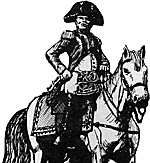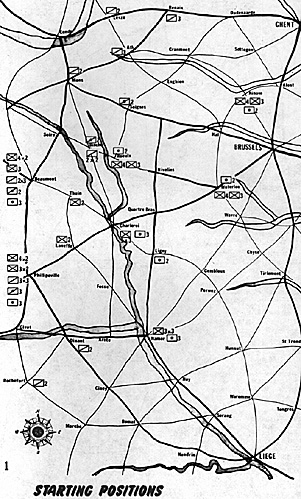 What follows is an account of a recent
game of Gamma Two Games' NAPOLEON which
should demonstrate some dos and don'ts for
those who play this game. The players'
names are withheld to protect the losers,
but rumor has it that the French were
commanded by a certain brilliant but
modest editor of a small, but popular,
wargaming magazine.
What follows is an account of a recent
game of Gamma Two Games' NAPOLEON which
should demonstrate some dos and don'ts for
those who play this game. The players'
names are withheld to protect the losers,
but rumor has it that the French were
commanded by a certain brilliant but
modest editor of a small, but popular,
wargaming magazine.
ALLIED SET-UP: (Chart 1)
Since the French can start much more concentrated, and they also get the first move, the Allies cannot afford a major battle on the first few turns - until they can concentrate. Further, since Ghent, Brussels and Liege must be protected, the Allies cannot concentrate completely until the French commit themselves toward one, or at most two, so that we can stop worrying about the other(s).

Therefore the main Allied forces must be protected from an early encounter with the French, and the 3 cities from a quick dash around the flanks by covering all the roads out of France with 1 unit each. In most cases these are cavalry, to give a better chance of surviving pursuit fire. An important point to note is that the second French move is a night move, when no attacks are possible. This gives us two moves in which to concentrate. Thus the major forces are placed within 2 moves of each other, yet spread out to cover the approaches to the 3 cities.
The Prussian cavalry force at Binche is fairly safe from attack since only 3 French units can cross the river from Soire, the Allies have many unit! in position to reinforce from adjacent towns, and being cavalry, can always retreat fairly safely. In addition to blocking the road through Binche (which could be done by 1 unit) this force is in position to reinforce Charleroi, go to the aid of the British. or even back toward Liege (which it could reach in 3 moves).
FRENCH SET UP & FIRST MOVE (Charts 1 and 2)
This set up and first move takes maximum advantage of the French ability to start out more concentrated and utilizes this capacity of the roads to tie maximum order to stay concentrated while advancing. The general strategy is that o the "central position", as actually used by Napoleon in the Waterloo campaign by advancing north through Charleroi can hopefully get between the main British and Prussian forces and defeat them one at a time. The cavalry move to Dinant is a threat to Leige and Namur to prevent the Prussians from moving west to join the British, The horse artillery stops at Phillipevillt because the roads beyond there are already utilized to the maximum. But here it can serve as a reserve, or reinforcment, for either the cavalry at Dinant or the mix of force at Laneffe.
ALLIED FIRST MOVE: (Chart 3)
The Prussians move to block the French threat to Liege while the one unit left in Namur protects it, for the next French move is night when occupied towns cannot be entered. The British, perceiving that Ghent is not threatened, move everything from Ninove to Hal, on the way to Waterloo.
FRENCH SECOND MOVE (NIGHT):(Chart 3)
Since no advance is possible into occupied towns a force is sent to Fosse to threaten Namur while increasing the number of units that can move into Charleroi by opening up a third road.
ALLIED SECOND MOVE: (Chart 4)
The Prussians pull back to avoid being attacked by overwhelming odds, to combine with the artillery unit at Ligny, and to be nearer to Liege and Namur. The British continue their concentration at Waterloo.
FRENCH THIRD MOVE: (Chart 4)
A force of infantry and foot artillery, large enough to beat the Prussians at Ligny, continues the advance, while the cavalry sent to Namur prevent the unification of the Prussian forces at Liqny and Ciney, threatens a move on Brussels via Wavre, and is closer to Lieqe than the Prussians are. (The cavalry at Dinant could not be used because only two groups can move, and the infantry advance requires that the Thuin and Laneffe forces be the two used.)
ALLIED THIRD MOVE (NIGHT): (Chart 5)
The Prussians see that they must choose between defending Lieqe against a cavalry raid or aiding the British against the French main force and choose the latter course by joining in the concentration of a major force in the neighborhood of Waterloo.
FRENCH FOURTH MOVE: (Chart 6)
The cavalry force at Namur moves toward Leige to occupy it and begin the drain on the Prussian army. The larger cavalry force from Dinant moves to replace them at Namur, from which it threatens Brussels, is within 1 move of Charleroi (via Fosse) and is in position to reinforce or join in any future attack on the Prussians at Ligny.
ALLIED FOURTH MOVE: (Chart 7)
The British continue their concentration at Waterloo while the Prussian cavalry moves to block the road to Brussels via Wavre against an advance from Namur.
FRENCH FIFTH MOVE(NIGHT): (Chart 7)
The cavalry continue on to Leige while the infantry at Fosse join the main force at Charleroi preparatory to an advance.
ALLIED FIFTH MOVE: (Chart 8)
The British move the horse artillery unit from Soignes to Hal, preparing for a French Advance, while the Prussian cavalry spreads out to screen Brussels against the French cavalry. The Prussian cavalry unit at Rochefort is removed due to the French holding Leige.
FRENCH SIXTH MOVE: (Chart 8)
All the force the road will carry advances, at last, on Quatre Bras, separating the Prussians at Ligny from the British at Waterloo, while secure from the poss ' ibility that both might attack me since the next Allied move is, a night turn. Meanwhile the cavalry from Namur move to threaten Brussels, penetrate the Prussian screen and accelerate the Purssian collapse by (probably) eliminating another Prussian unit.
ALLIED SIXTH MOVE (NIGHT): (Chart 9)
The Prussians move to block the French cavalry from Brussels aqain while the British continue to bring up outlying units. The Prussians remove the artillery unit from Ciney due to the French in Liege.
FRENCH SEVENTH MOVE: (Chart 9)
The two units still at Thuin are moved up to within reinforcing range of the main body while the cavalry move to Chyse to threaten Brussels and, hopefully, to eliminate an eighth Prussian unit, which it does and thus the Prussian Army is defeated and removed!
BRITISH SEVENTH MOVE: (Chart 10)
The forces at Hal are sent, via Brussels, to block the French cavalry from moving to Brussels.
FRENCH EIGHTH MOVE (NIGHT): (Chart 10)
The forces at Charleroi join the main body at Quatre Bras, ready at last (now that the Prussians are gone) to take on the British. The cavalry at Leige move to join either the rein body or the cavalry at Chyse.
BRITISH EIGHT MOVE: (Chart 11)
To avoid a battle with the fully united French main force the British fall back to Brussels. Playing for time it is possible to abtain a draw game by avioding a British defeat. Since only 8 units can use the road to Brussels, 2 are sent to Wavre, making a force large enough to fight the French cavalry if necessary.
FRENCH NINTH MOVE: (Chart 11)
As much of the main force as can use the road follows the British main force, while the cavalry from Hannut units with the cavalry at Chyse.
BRITISH NINTH MOVE (NIGHT): (Chart 12)
The force at Wavre rejoins the main force now at Brussels.
FRENCH TENTH MOVE: (Chart 12)
Afraid that if I take the time to bring up the forces at Quatre Bras the British will slip away again, the main force moves to attack without them, joined by all the cavalry from Chyse that can cross the river at Wavre. The rest of the cavalry attacks the single British unit at Louvain to eliminate it and to be in position to reinforce the main army during the battle.
Maps (Large: very slow: 330K)
Final Battle of Brussels Deployment and Recap
Back to Campaign #71 Table of Contents
Back to Campaign List of Issues
Back to MagWeb Master Magazine List
© Copyright 1976 by Donald S. Lowry
This article appears in MagWeb (Magazine Web) on the Internet World Wide Web. Other military history articles and gaming articles are available at http://www.magweb.com